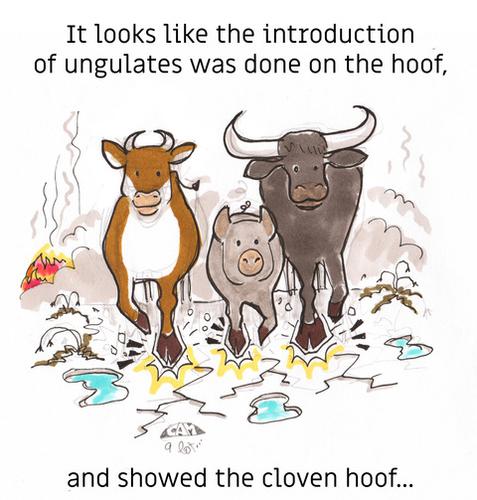当前位置:
X-MOL 学术
›
Austral Ecol.
›
论文详情
Our official English website, www.x-mol.net, welcomes your
feedback! (Note: you will need to create a separate account there.)
An overview of the impacts of feral cattle, water buffalo and pigs on the savannas, wetlands and biota of northern Australia
Austral Ecology ( IF 1.6 ) Pub Date : 2021-05-01 , DOI: 10.1111/aec.13046 Helenna Mihailou 1 , Melanie Massaro 1
Austral Ecology ( IF 1.6 ) Pub Date : 2021-05-01 , DOI: 10.1111/aec.13046 Helenna Mihailou 1 , Melanie Massaro 1
Affiliation

|
Since the extinction of the megafauna some 45 000 to 50 000 years ago, grazing pressure on Australian savannas has been relatively low compared to that on savannas in other continents. However, the introduction of several species of ungulate, primarily during the 1800s, and the establishment of large feral populations in northern Australia has resulted in an increase in grazing pressure compared to pre-colonial times when soft-footed macropods were the largest extant grazers. Here, we provide an overview of the introduction of three key ungulates to northern Australia: cattle (Bos taurus, B. indicus), Asian water buffalo (Bubalus bubalis) and pigs (Sus scrofa), and the impact of these populations on both abiotic and biotic elements of savanna habitats in northern Australia. Feral ungulate populations have considerable impacts on soil, water quality, waterhole hydrology, vegetation, fire regimes and the spread of exotic plants, and resulting changes to habitat have flow-on effects for native wildlife. Ungulate impacts on vegetation communities and associated changes in fire regimes are particularly concerning given that sustained grazing can lead to the permanent removal of key grass species and changes in fire intensity and frequency can result in the conversion of grassland to woodland. Native wildlife can be affected by ungulate disturbance in a multitude of ways, but overwhelmingly, habitat loss or degradation is the main driver for declines in biodiversity. Based on current knowledge gaps, we discuss potential directions for future research about how feral ungulate activity affects Australian native species and their impact on savanna habitats.
中文翻译:

野牛、水牛和猪对澳大利亚北部热带稀树草原、湿地和生物群的影响概述
自大约 45 000 至 50 000 年前巨型动物灭绝以来,与其他大陆的稀树草原相比,澳大利亚稀树草原的放牧压力相对较低。然而,主要是在 1800 年代引入了几种有蹄类动物,以及在澳大利亚北部建立了大量野生种群,与软足巨足类动物是现存最大的食草动物的殖民前时期相比,放牧压力增加了。在这里,我们概述了澳大利亚北部引入的三种主要有蹄类动物:牛(Bos taurus, B. indicus)、亚洲水牛(Bubalus bubalis)和猪(Sus scrofa),以及这些种群对澳大利亚北部稀树草原栖息地的非生物和生物元素的影响。野生有蹄类动物种群对土壤、水质、水坑水文、植被、火灾状况和外来植物的传播有相当大的影响,由此产生的栖息地变化对本地野生动物产生了流动影响。有蹄类动物对植被群落的影响和火灾状况的相关变化尤其令人担忧,因为持续放牧会导致关键草种的永久移除,而火灾强度和频率的变化可能会导致草地转变为林地。本土野生动物可能会以多种方式受到有蹄类动物干扰的影响,但绝大多数情况下,栖息地丧失或退化是生物多样性下降的主要驱动因素。根据目前的知识差距,
更新日期:2021-05-01
中文翻译:

野牛、水牛和猪对澳大利亚北部热带稀树草原、湿地和生物群的影响概述
自大约 45 000 至 50 000 年前巨型动物灭绝以来,与其他大陆的稀树草原相比,澳大利亚稀树草原的放牧压力相对较低。然而,主要是在 1800 年代引入了几种有蹄类动物,以及在澳大利亚北部建立了大量野生种群,与软足巨足类动物是现存最大的食草动物的殖民前时期相比,放牧压力增加了。在这里,我们概述了澳大利亚北部引入的三种主要有蹄类动物:牛(Bos taurus, B. indicus)、亚洲水牛(Bubalus bubalis)和猪(Sus scrofa),以及这些种群对澳大利亚北部稀树草原栖息地的非生物和生物元素的影响。野生有蹄类动物种群对土壤、水质、水坑水文、植被、火灾状况和外来植物的传播有相当大的影响,由此产生的栖息地变化对本地野生动物产生了流动影响。有蹄类动物对植被群落的影响和火灾状况的相关变化尤其令人担忧,因为持续放牧会导致关键草种的永久移除,而火灾强度和频率的变化可能会导致草地转变为林地。本土野生动物可能会以多种方式受到有蹄类动物干扰的影响,但绝大多数情况下,栖息地丧失或退化是生物多样性下降的主要驱动因素。根据目前的知识差距,











































 京公网安备 11010802027423号
京公网安备 11010802027423号